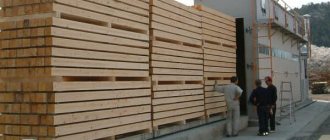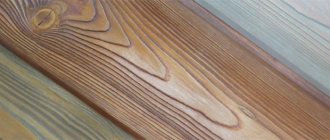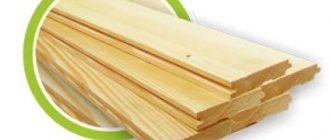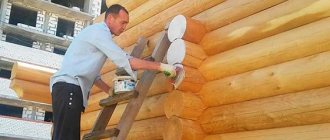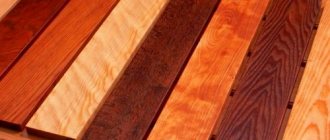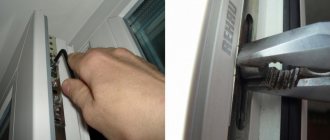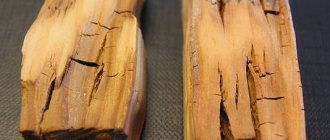Drying lumber and wood blanks has always been and remains the most important technological operation in the production of wood products. The process of reducing wood moisture content using an industrial method should be considered the main one - for several reasons. Firstly, because it is still manageable, and, secondly, it is much shorter than natural drying.
Controlling the drying process involves monitoring and regulating the evaporation of moisture from the surface of the wood. The intensity of evaporation is maintained by the temperature and humidity of the drying chamber environment.
By and large, a drying chamber is a complex of technological equipment designed specifically to remove excess moisture using thermal heating. The most important criterion for drying is reducing the amount of moisture while maximizing the preservation of the technological properties of wood.
"A C"
The current state of drying equipment at Russian enterprises can only be described as satisfactory. Sawmills and woodworking industries that have been operating for a long time use a large number of drying chambers of old designs that require significant modernization. And in some cases, cameras are only listed on the balance sheet, but do not work.
In order to properly dry lumber in such conditions, production workers spend enormous amounts of energy and labor. It turns out to be a kind of vicious circle. It is not possible to invest in the re-equipment of drying equipment due to the lack of necessary financial resources. As a result, the company does not have enough resources for effective growth.
Disadvantages of technology
The main criticism of this drying technology comes down to the risk of the formation of numerous defects in lumber during the operation. One of the most common of these is warping. Violation of technology can provoke both longitudinal and transverse deformations.
Typically, such processes are the result of insufficient moisture removal before the main drying stage. Often the material develops defects in the form of cracking at the ends. Similar defects arise if the lumber dryer operated in the configured mode during the initial warm-up stage. The technology requires that this process, even at minimum temperatures, be carried out under conditions of softening the structure of the lumber.
Is modernization needed?
It is irrational to start re-equipment with the purchase of equipment. Old drying chambers built from bricks, blocks, panels and other building materials, as a rule, require major repairs of enclosing structures (walls, ceilings, doors). If this is not done, then further re-equipment will be a waste of money. Significant heat losses will again lead to increased energy consumption, and therefore will not reduce the cost of drying lumber. There is only one way out - to do repairs or reconstruction (depending on the condition).
The old fashioned way
Previously, sawmills and woodworking enterprises built dryers with high productivity, which were used mainly for drying lumber to transport moisture. These are continuous chambers (for example, TsNIIMOD-49, TsNIIMOD-32, TsNIIMOD-24, NB, models with zigzag circulation, SP-5KM, etc.).
If in such chambers, inherited from Soviet times, in accordance with modern requirements, they try to dry lumber to an operating humidity of 8-10%, then it will not be possible to achieve a good result. There will be a large percentage of defects, the wood will dry unevenly. You should not expect high-quality drying of lumber in chambers of outdated designs, which implement outdated technology (ejection, gas chambers).
Homemade
Some manufacturers of wood products do not pay enough attention to drying production, mistakenly believing that they can create a drying chamber with their own specialists, not caring at all about the fact that they do not have knowledge of the process technology and design of such equipment. Because of this, in such home-made drying kilns, problems arise in practice related to obtaining high-quality lumber.
When building it yourself, they are usually guided either by the experience of a neighbor who has built a similar one, or by information from advertising brochures of drying chamber manufacturers, and often simply by relying on their own experience. This is mainly done by small woodworking enterprises with relatively low needs for dry lumber.
In the homemade version, the dryer is a closed heated room (usually with smooth or finned heating pipes placed on the walls) with a door for loading lumber. Exhaust air ducts are provided to release moist air. Often there is not only an automation system for controlling parameters, but also simple measuring instruments for visual monitoring of temperature and humidity of the environment. At the same time, the drying process is carried out almost uncontrollably, with the absence of any technology and modes.
At the first glance at such a “drying chamber,” one immediately notices the clearly insufficient circulation, unorganized movement of the drying agent in the chamber, lack of heat supply, and improperly organized supply and exhaust ventilation with the environment.
Lumber in such conditions turns out to be of poor quality. There is great unevenness of drying, a large number of defects - cracks, warping of assortments. In addition, the duration of the drying process in them is excessively extended. The material constantly has to be reloaded and sent back to dry.
Naturally, with a reasonable approach, you can build a drying chamber yourself, but still, in order not to make a large number of miscalculations in the design, it is better to contact specialized organizations, specialists in wood drying.
Warming up the wood
Primary heating is required to prevent stress on the internal structure of the lumber during the main drying. An intense but short-term thermal effect is produced, during which the moisture does not evaporate. In parallel with the heat treatment, saturated steam is sent into the chamber. This function is performed by a group of fans with heaters. The process of evaporation of moisture throughout the entire thickness of the material will begin only after the cessation of thermal exposure.
Again, so that chamber drying of wood does not damage its structure, already at the first stage of heating, the balance between the temperature regime and the rate of humidity drop is regulated. If this balance is disturbed, there is a risk of cracks. The duration of this procedure is determined by the external conditions and characteristics of the wood - on average from 1 to 2 hours.
A Question of Choice
Of course, the current state of lumber drying in Russia is not determined solely by the above. When organizing new productions, as well as when modernizing existing ones for the production of competitive high-quality wood products, they try to equip the production with modern equipment, including modern drying chambers. And it is right. However, here it should be noted that when investing in new production, entrepreneurs put the choice of a drying chamber in last place. Caring about technology and purchasing woodworking machines, for some reason they believe that choosing the necessary drying chamber will not be difficult. But this only seems to be a simple matter. There are many nuances that need to be taken into account.
Drying and modes in more detail
The very first stage of drying is always stacking lumber. Maintaining the correct geometry and uniform drying directly depends on its correctness. To achieve an ideal result, the stack should contain pieces of the same thickness and the same type of wood. For ease of sending to the chamber and subsequent removal, the stacks are formed on a trolley moving on rails.
Primary moisture and heat treatment is carried out immediately after placing the stacks inside the chamber. To do this, the inflow and ventilation channels are closed, and the wood is treated with steam from humidifying pipes. After this, the drying mode starts: forced heating and airflow are activated.
In the soft and normal drying modes, there are 3 stages. The transition to the second stage is carried out when the material moisture reaches 30%, to the third - 20%. In this case, there is a gradual decrease in humidity in the chamber itself and an increase in temperature, but at no stage should it exceed 100°C.
High temperature drying consists of only 2 stages. The transition between them is carried out at a wood moisture content of 20%.
You need to know the nuances
Recently, a trend has developed in the forestry industry that investors are investing in production that brings profit in the short term. Because of this, recently they have been trying to build drying chambers in the form of easily and quickly erected insulated metal structures. But here too the question of choice arises. When considering various types of construction (convective, condensation, aerodynamic, vacuum), as a rule, they focus on cost.
Some manufacturers of drying chambers, in an effort to sell their product, do not particularly educate the client, praising their chamber.
Entrepreneurs often order a chamber with a large loading capacity (60-100 m3), mistakenly believing that they will be able to load all the material into it at the same time, including different thicknesses, and in the future it turns out that, having a large chamber, they underload it and violate the technological process.
Type of heating
Today, a fairly common phenomenon is the desire of most owners of drying kilns and those who are just planning to purchase one to establish heat supply from a hot water boiler that runs on sawmill and woodworking waste. At the same time, many have little idea about the required amount of waste and consider this option to be the cheapest. Maybe in the case of high-power boiler houses of 1-2 MW or more, this is true. Moreover, such boilers are also considered as a wood waste recycler at their enterprise.
In fact, when organizing a small boiler room for autonomous heat supply to the drying chamber, it is more economical to use electric heating or water heating boilers running on gas, diesel fuel and coal. The automatic burner of gas boilers does not require the presence of an operator. In regions with low electricity costs, electric boiler systems are naturally common. Automation of the drying and heat supply process affects the cost reduction, therefore, in the end, it turns out cheaper, or at least is at the level of heating the chamber with woodworking waste.
Pros of technology
Chambers with temperature and humidity treatment allow drying processes to be carried out while fully preserving the environmental friendliness of the material. In most cases, such processing methods do not require the use of active chemicals that increase the efficiency of the process. The high quality of the result is also noted. If the operator did not make mistakes when organizing the process, the resulting timber will acquire high strength and protective qualities.
Many people also point to the high productivity of chamber drying of wood. The pros and cons, however, agree on this characteristic. On the one hand, batch processing does allow large volumes of wood to be serviced in short time intervals. On the other hand, the inability to process small packages with a reduced load limits the scope of application of such equipment.
Vector for deep processing
The fact that today wood processors are trying in one way or another to organize drying production at their enterprises indicates a desire to engage in deep wood processing, which brings great profit.
An increase in duties on the removal of round timber will lead to an even greater increase in the volume of deep wood processing in Russia. The development of the industry will inevitably affect a significant increase in drying capacity. The prospect for the development of wood drying in Russia as one of the fundamental stages in the production of high-quality wood products, which are used in many industries.
Preparation of material
The quality of drying largely depends on how correctly the stacks were prepared - the so-called packages of lumber, which are specially formed to be placed in the chamber. For example, uneven drying and deformation of individual areas on the boards will be the result of improper packaging.
There are usually two methods of this kind of preparation:
- single stack;
- batch formation of bookmarks.
In the first case, one stack includes several boards folded in the same configuration. Batch stacking assumes that the lumber will be stacked in several ready-made stacks. A rigid platform with a flat surface is used as the basis for the stack. It can be a rail trolley formed by separate tracks.
In order for chamber drying of wood to be carried out without leakage of the thermal agent, underloading of the stack is not allowed. It must be completely filled either with boards of the same length, or with lumber of different sizes staggered. One or more layers of lining are provided between the boards being joined.
Different approach
What is important, in my opinion, is the correct choice of drying chamber design, taking into account the performance and quality of drying, and not cost, which is the main criterion today. For example, for a large sawmill producing tens of thousands of cubic meters of materials per year, it is necessary to select chambers with high productivity (drying tunnels, condensation dryers, etc.).
For those entrepreneurs who work with difficult-to-dry hardwood (including exotic) wood, and usually process small volumes, you should pay attention to vacuum dryers, microwave-heated chambers, ultrasonic and the like. With these special methods, it is possible to dry valuable types of wood in blanks efficiently and quickly.
When choosing a specific chamber design, you need to clearly understand what you want to dry and for what purpose.
Vacuum drying
The vacuum drying chamber for wood is designed for valuable types of timber, such as teak, wenge, rosewood and others. This unit operates from convection heating of wood and vacuum removal of excess moisture. The process takes place at a maximum temperature of +65. However, due to a vacuum pressure of 0.09 MPa, boiling occurs at 45.5. Such conditions make it possible to dry the wood without the aggressive effects of high temperature. Thus, high internal stress does not arise and the wood is not subject to cracking.
During drying, when the temperature rises to 65 degrees, the automation turns on and the electric boiler turns off. The upper layers of timber slowly cool, and moisture from within flows to drier areas. During one drying period, about 250 such cycles occur. Under such conditions, moisture is evenly drawn out along the length and depth of the material. After drying, the material is characterized by a moisture level within 4-6%.
Are imported ones better?
I cannot agree with the opinion that the prospect for the development of wood drying in Russia lies only in the acquisition of imported drying chambers. The existing stereotype that imported dryers, although much more expensive in cost, allow drying to be of higher quality than domestic ones, is far-fetched and does not have strong and unambiguous evidence. Often, in confirmation of this, not the best example is given with the domestic and foreign automobile industry. Then the question arises: is it even possible to dry qualitatively not in imported dryers? In my opinion, it is possible to dry, if not better, then at exactly the same quality level, in domestic drying chambers.
The main advantages of imported drying chambers are their housing, consisting of aluminum panels, as well as automatic control systems that ensure high-quality drying.
However, the body of the drying chamber made of aluminum can be manufactured with high quality by most domestic enterprises. In addition, Russian manufacturers also complete their designs with imported components (fans, heat exchangers, control systems, etc.). I am confident that domestic companies are quite capable of developing and manufacturing new competitive designs of drying chambers.
In practice, when using imported chambers, problems arise, most often associated with the operation of the automatic drying process system. In most cases, lumber is dried according to factory programs installed in the control unit, and therefore completely rely on automation. Even with a minor malfunction in its operation, personnel are lost, and not everyone knows how to adequately control the camera in manual mode.
Buy or restore?
Again, returning to the topic of modernization, it should be noted that there is not always a need to buy a new drying chamber, demolish the old one and build a new one. If the condition of the drying chamber enclosing structures is in satisfactory condition, then reconstruction or equipping the dryer with modern equipment is a good option. Of course, if serious restoration is required, then the cost of reconstruction may be the same amount as the construction of a new drying chamber, then reconstruction is not advisable.
Often the need for reconstruction is dictated not only by the wear and tear of equipment or the destruction of fences, but by the task of reducing energy costs and improving the quality of drying or increasing the productivity of the dryer.
Main stage
After the initial warm-up, drying immediately follows. But the transition must be gradual, which is reflected in the slow opening of the air exchange dampers that remove moisture. At the same interval, the optimal parameters of heat flows are established. The temperature regime, in turn, is regulated by the opening level of the chamber blinds. If it is necessary to increase the saturation of the agent, the inlet pipes are completely closed.
Also, the degree of saturation of the thermal effect can be adjusted by starting the steam generator. However, steam injection systems cannot be connected when the hood is open. During the operation, chamber drying of wood is controlled by temperature characteristics and its error. In production, information about these values is usually entered into a log every hour.
